A Big Spread-2
A fter yesterday's post about the upcoming Bacchus collection I had a couple of follow-on thoughts. Firstly, all those ugly little creatures were drawn by Pete Mullins. You can see how he's turned this one into a Kubrick reference:

They are called the screaming habdabs:

One of the saddening tendencies of the late comic books is the habit of getting literal. There are some obvious outward signs of this. One such example is the decline of the thought balloon, because although we hear the speech of others, as seen in their speech balloons, we are not privy to their thoughts and so, the theory goes, these should not be made visible. Thus in the more literal-minded comics of our days, such as those from Vertigo, thought balloons have been expunged and replaced by the cinematic technique of the voice-over.
Another comics trick that has largely gone south is the speaking building. This was a staple of the newspaper Illustrated strips, used as a way of setting a scene while simultaneously jumping into the dialogue. It could also be a way of breaking up a static conversation, by cutting to an exterior view. But this had to go. Why? Because buildings don't speak.



I have always liked the talking building:

But the talking building has got nothing on the thinking truck:

***********************************
Just pointed out to me is this interview with Stephen King from May 14 2010 :

They are called the screaming habdabs:
abdabs /ˈabdabz/ (also habdabs)The habdabs have often been read as synonym for Delirium Tremens (or 'giving the invisible man a handshake') an unspeakable condition that I personally hope never to suffer. Tremens is a character in the story, and thus so are the habdabs. The great thing about cartooning in its very essence, is that nothing is literal. Abstract ideas, propositions, medical conditions, can be made into characters. A character can wear all of his guilt in a wretched suit of Tattoos.
▶plural noun
Brit. informal (often in phr. the screaming abdabs) nervous anxiety or irritation.
– origin 1940s: of unknown origin.

One of the saddening tendencies of the late comic books is the habit of getting literal. There are some obvious outward signs of this. One such example is the decline of the thought balloon, because although we hear the speech of others, as seen in their speech balloons, we are not privy to their thoughts and so, the theory goes, these should not be made visible. Thus in the more literal-minded comics of our days, such as those from Vertigo, thought balloons have been expunged and replaced by the cinematic technique of the voice-over.
Another comics trick that has largely gone south is the speaking building. This was a staple of the newspaper Illustrated strips, used as a way of setting a scene while simultaneously jumping into the dialogue. It could also be a way of breaking up a static conversation, by cutting to an exterior view. But this had to go. Why? Because buildings don't speak.



I have always liked the talking building:

But the talking building has got nothing on the thinking truck:

***********************************
Just pointed out to me is this interview with Stephen King from May 14 2010 :
But he fell away from the genre for several years, and in that time the form had evolved considerably, which made writing for the medium a new challenge for even as seasoned a writer as King. “You have to be very humble, and you have to take advice because it’s a new way of seeing, to actually write it is a new way of writing...Poor old Stephen King, made to write in the Vertigo house style. I hope he didn't go away thinking all of comics work that way.
One example:Thought bubbles—those puffy, dotted clouds that were a staple of early comics—have been phased out. “I got this kind of embarrassed call from the editors saying, ‘Ah, Steve, we don't do that anymore.’ ‘You don't do that anymore?’ I said. ‘No, when the characters speak, they speak. If they're thinking, you try to put that across in the narration, in the little narration boxes.’” So King happily re-wrote to fit the new style—though he still laments the loss of the thought bubble. “I think it's a shame to lose that arrow out of your quiver. One of the nice things about the written word as opposed to the spoken word in a movie is that you can go into a character's thoughts. You do it in books all the time, right?”
Labels: A Big Spread, balloons
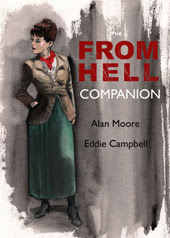


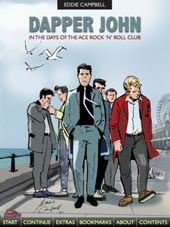
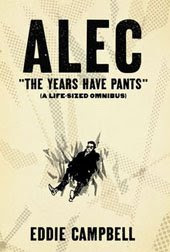
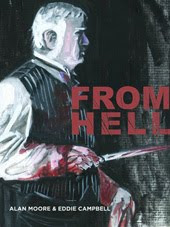
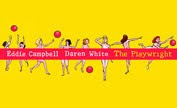
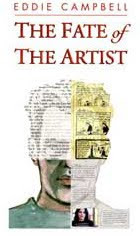
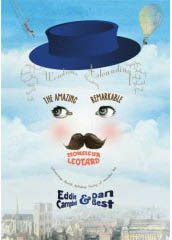





9 Comments:
And let's not forget the talking smoke. (See Watchmen #3, page 9, panel 3). Much, much before Lost!
Hi Eddie,
I was casually talking about this, the thought balloon, a couple of days ago over breakfast with a friend. And on how establishing film as a primary influence over the years has "robbed" us of many many things (and given a lot, of course). I'm also thinking on an interview Argentinean cartoonist Liniers gave on a news channel last week about graphic novels. The show he was on was about books, the anchorman of the show usually brings a guest to recommend books on a determinate topic. That episode's focus was on graphic novels, and Liniers was recommending different books (all fine, mighty examples on their own) but on one point, explaining what the graphic novel is about, he mentions something like "comics take the best elements from literature and film" to produce a new thing.
I've been thinking about it, why the word "film".
Whyle I'm at it! Santiago! I managed to get "La Novela Grafica" a couple of days ago, I'm reading it now, I'll make sure to write to you about it soonish. Beautiful work so far.
Loris, thanks for you words. I hope you enjoy it. Let me know what you think when you get to the end. You can find my email in the profile section at my blog: http://santiagogarciablog.blogspot.com/
Back when I was a teenager (1987?) just getting into 'serious' comics, as teenagers do, I managed to convince a teacher to let me do an exam assignment in the form of a Watchmen critique. The absence of thought balloons was just one of the many major bombshells I dropped on the examining board's disinterested collective head, along with the similar lack of motion lines (except when Rorschach throws the comedian's badge on the table) and probably quite a few pages about the 'visual rhymes'.
At any rate, looking back it was as much a curse as a blessing to be discovering comics at that time, because for all the richness on offer I was tainted with this notion that thought balloons were an embarrassment tolerable if used for comic effect (arf) but generally best left in Topper and Dandy annuals, and I'd cringe if I saw one hanging over, say, Batman's head. "Oh, Batman, what have they done to you?"
It was Love and Rockets that redeemed the thought balloon for me, specifically a panel of Human Diastrophism where a character hides under a bed and observes that he'd better not fart. Somehow that panel cured me.
Anyway, I got a C overall, but do bear in mind the critique was only a part of that.
Idea for gag cartoon: long shot of office skyscraper, speech balloon coming from it saying "God, I'm bored." Sell it to the New Yorker and they'll move the text to a caption. Possibly an improvement.
Never mind talking buildings; in at least one of Jack Kirby's monster copmics from the early sixties, he pulled back to show the planet Earth with word balloons coming from it.
David Simpson
The talking building is really just comics' equivalent of the TV or movie establishing shot, which may well allow you to hear an opening line or two of the dialogue inside while still showing the building's exterior on-screen.
It seems foolish for comics writers to throw away such a handy and economical device when other visual media use it with no embarrassment at all. Is this the "cultural cringe" of comics' perceived inferiority?
The height of the speaking building is perhaps the Peanuts building that really is speaking in thought balloons.
http://madinkbeard.com/archives/favorite-peanuts-strip
I read something about thought balloons back on Comicscomics when it was still around.
http://comicscomicsmag.com/2010/03/the-problem-with-american-vampires-is-that-they-just-dont-think.html
ah, Joe already covered the subject. The Stephen King interview came up while I wasn't blogging, but I have always been clear about which side I'm on in the thought balloon debate. I wrote here on 18 December 2006:
The 'thought' bubble (or balloon) is one of the few inventions truly indigenous to the twentieth century comic strip and it would be sad to reject it in order to make comics more like movies, or because it is somehow pictorially unseemly for a tough heroic figure to have fluffy clouds around his head. When you tell an anecdote orally it's commonplace to say 'I thought' and 'she thought' etc., and perfectly logical to codify that on paper in a thought bubble. And if it makes your character less heroic, try taking the pole out of his ass. Always works for me.
Thanks for the Peanuts link, Derik. I'd never seen that one.
Post a Comment
Subscribe to Post Comments [Atom]
<< Home